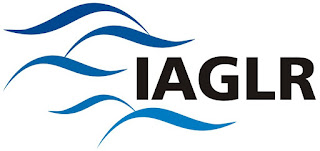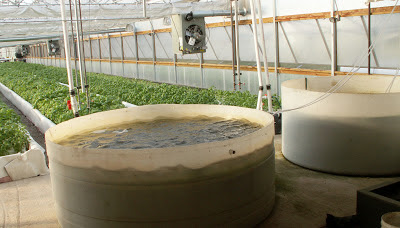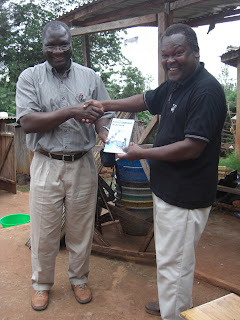 IISG staffers will join hundreds of scientists, environmentalists, and government representatives June 2-6 at the Conference on Great Lakes Research. Spread across each day of the conference, their presentations will cover vital work on Sea Grant education initiatives, new tools that help officials protect aquatic ecosystems in the Great Lakes region, and more.
IISG staffers will join hundreds of scientists, environmentalists, and government representatives June 2-6 at the Conference on Great Lakes Research. Spread across each day of the conference, their presentations will cover vital work on Sea Grant education initiatives, new tools that help officials protect aquatic ecosystems in the Great Lakes region, and more.Category:
IISG specialists among the presenters scheduled for next week’s IAGLR 2013 conference
May 30th, 2013 by Irene Miles IISG staffers will join hundreds of scientists, environmentalists, and government representatives June 2-6 at the Conference on Great Lakes Research. Spread across each day of the conference, their presentations will cover vital work on Sea Grant education initiatives, new tools that help officials protect aquatic ecosystems in the Great Lakes region, and more.
IISG staffers will join hundreds of scientists, environmentalists, and government representatives June 2-6 at the Conference on Great Lakes Research. Spread across each day of the conference, their presentations will cover vital work on Sea Grant education initiatives, new tools that help officials protect aquatic ecosystems in the Great Lakes region, and more.Food web complexity one of several panel topics at upcoming 2013 IAGLR conference
May 22nd, 2013 by Irene MilesPresentations will discuss a range of issues that help determine just what eats what in the lake. Several will focus on what happens to the diet of native species when invaders like quagga mussels, round goby, spiny water flea deplete food resources. Others will introduce how shifts in phosphorus and other nutrient levels may be behind recent changes at the bottom of the food web and compare the eating habits of forage fish over the last two decades.
The session is a part of ongoing regional efforts to improve understanding of the complicated relationships between the many different microbes, plants, and animals that call Lake Michigan home. Since 2010, IISG and other partners in the Great Lakes Regional Research Information Network have funded several studies on the links that form the food web.
In addition to serving as co-chair, Tomas will join researchers from across the Great Lakes to present the findings of three studies slated for the session. For a description of these and other presentations, visit the session schedule and click on the presentation titles.
The International Association for Great Lakes Research’s (IAGLR) 56th Annual Conference on Great Lakes Research is sponsored by IISG and Purdue University. To view the entire program, visit the conference website.
IAGLR 2013 panels to focus on new and historic contaminants
May 15th, 2013 by Irene MilesIISG’s Laura Kammin will co-chair a two-part session on the impacts and management of contaminants at this year’s Conference on Great Lakes Research, June 2-6 at Purdue University. Researchers will present on a range of issues, including contaminant testing, impacts to wildlife, and pollution trends over time. With 24 presentations spread over two days from researchers, resource managers, and industry representatives, it will be the conference’s largest session.
In the news: Aquaponics could revolutionize urban eating
March 11th, 2013 by Irene MilesIllinois-Indiana Sea Grant, along with several other Sea Grant programs, universities, and researchers, have been involved in advising and establishing a number of aquaculture operations in the U.S. and around the world, including some aquaponics facilities. This video from our friends at Purdue University provides a terrific amount of detail about aquaponics and how the process could help sustainably grow food.
With the ability to grow plants and fish in a mutually beneficial system, aquaponics presents an especially viable and sustainable option to provide healthy and locally grown food for urban areas.
From The Atlantic Cities:
“Aquaponics is a method of combined fish and vegetable farming that requires no soil. The farmer cultivates freshwater fish (aquaculture) and plants (hydroponics) in a recirculating water system that exchanges nutrients between the two. Wastewater from the fish serves as organic fertilizer for the plants, while the plants clean the water of fish feces and urine. The net result: a 90 percent reduction in freshwater use compared with conventional fish farming, and a significant reduction in added nutrients such as fossil fertilizers. The system can be run without pesticides and, because the fish environment is spacious and clean, without antibiotics…In the lab, the pumps made gushy sounds at regular intervals. The water dripped. As the plants’ leaves evaporated moisture, I could hear the place breathe. I picked a ripe, red tomato from a vine. This lab, I sensed, could morph into an urban oasis: a lush, breathing organism inside the city. Unlike static green spaces like parks, this would be an actual farm as well as a place of tranquility in the city — not to mention a space that could generate the food to feed that city, with minimal harm to the environment or human health, just steps from residents’ tables.”
Follow the link above to the complete article, and visit our aquaculture webpage for more information.
IISG’s Kwamena Quagrainie promoted to new position
February 7th, 2013 by Irene MilesIISG’s Aquaculture Marketing Specialist Kwamena Quagrainie, who also directs the aquaculture economics and marketing program at Purdue University, was recently promoted to the position of Clinical Engagement Assistant Professor in Agricultural Economics. Dr. Quagrainie has been involved for many years in aquaculture marketing and outreach, helping numerous aquaculture operations get started or expand their business throughout the Midwest. He has also been involved in international efforts to promote and foster aquaculture operations throughout several African nations.
IISG’s Kwamena Quagrainie recognized for his outreach and extension efforts
December 3rd, 2012 by Irene MilesThe Purdue University Cooperative Extension Specialist Association’s (PUCESA) mid-career Award “recognizes an Extension specialist with 11-20 years of service. Recipients would have demonstrated extension leadership; excellence in delivering public education programs; innovative approaches to program development; outreach efforts to county Extension educators; research that benefits Extension clientele through practical application; or demonstrated collaboration with county educators, agencies, or community leaders.”
“Since joining Purdue in 2005, Dr. Kwamena Quagrainie has revitalized the aquaculture industry in Indiana and overseas. Through applied research and Extension he has expanded aquaculture funding and improved business for thousands of fish farms.Kwamena’s leadership led to reorganization of the state aquaculture Extension team and development of a business management program for farms producing yellow perch, hybrid striped bass and freshwater prawns. Kwamena’s leadership was a driving force in the Indiana Soybean Alliance funding a 5-year Indiana Aquaculture Strategic Plan in 2007 resulting in up to $1 million annually in soybean check-off funds for aquaculture research and education in Indiana. Kwamena obtained additional research funding from USDA and Purdue to support Indiana aquaculture development. He actively collaborates with Indiana Department of Natural Resources, Indiana Board of Animal Health, and the Indiana Soybean Alliance. Kwamena is Indiana’s state coordinator for USDA’s North Central Regional Aquaculture Center, state representative on the National Association of State Aquaculture Coordinators and serves on USDA’s aquatic task force that is formulating standards for organic aquaculture nationally.Dr. Quagrainie’s domestic program is closely integrated with international activities through the USAID-funded Aquaculture and Fisheries Collaborative Research Support Program (AquaFish CRSP). As the Africa AquaFish CRSP project director, Kwamena secured $1.13 million since 2004 for research and outreach, including training in pond record keeping and business management. About 2,000 fish farmers in Tanzania, Kenya and Ghana can now use their farming records to secure bank financing…”
For more information about Illinois-Indiana Sea Grant’s aquaculture resources, visit our Aquaculture Economics & Marketing Resources page.
Early data from Michigan City buoy helps scientists, anglers, and boaters
November 6th, 2012 by Irene MilesThe research buoy launched off the coast of Michigan City, IN earlier this fall has been brought inland for winter, but will return to the water next spring for its first full season monitoring environmental conditions in Lake Michigan’s nearshore waters.
More than 500 people have visited the website since it went live in early September to see real-time snapshots of lake conditions or to examine trends shown over 24-hour and 5-day periods. IISG staff members have heard from sailors, kayakers, anglers, and local residents who say they plan to regularly use the information collected on wave height, water temperatures, and wind speed before venturing from shore. Sailors from Indianapolis told IISG that the up-to-date information on lake conditions will help them more safely make their seasonal trip from St. Joseph, MI to Michigan City. The same data will also be used by fisheries researchers at the Purdue University West Lafayette campus to determine when to make the two-hour drive up to the lake for sampling trips.
The buoy’s launch also attracted regional press coverage that continued well after it was placed in the water. Indiana TV and newspapers were joined by news outlets from Illinois and Michigan—including the Detroit Free Press—in their coverage. The launch was also featured in trade blogs such as the Environmental Monitor and recreational forums like the Great Lakes Angler Forum.
IISG and Purdue University launch Lake Michigan buoy to provide real-time data
September 17th, 2012 by IISG IISG staff members and interns traveled to the Indiana shoreline earlier this week to help launch an environmental sensing buoy four miles off the coast of Michigan City, Indiana. They were joined by researchers from the Purdue University School of Civil Engineering, who partnered with IISG to develop the buoy, and staff at the Indiana DNR.
“If I had to describe the launch process in one word, it would be ‘meticulous.’ The approximately 6-hour process was carefully divided into a series of steps: Steps for the final calibration of the real-time data sensors, steps for placing the 2,000 lb anchor on the lake bottom, steps for rigging the buoy up to be dragged behind the DNR boat to its final destination in 62-foot water, and still more steps for attaching it to the anchor’s line. To a passer-by the process must have looked a little hectic, with people running around securing lines and popping back-and-forth from the building to test light-sensitive sensors. And maybe things were a little chaotic at times, but a chaos complete with checklists.
This is not to say that the day played out without any hiccups. In fact, the whole thing almost had to be scrapped for another day because of a malfunctioning light needed to announce the buoy’s existence to nearby boaters. Cary Troy, the lead researcher on the project, had brought four of these lights from Purdue just in case one didn’t work. Four proved to be too few, though, when the time came to install it atop the buoy. We knew going in that the buoy might not be able to go out that day. There was always the chance that the weather would not be on our side that morning and we would need to wait for another, better day. But with the weather the best it had been for several days, the anchor sitting on a barge at the Port Authority ready to be carried out into the lake, and the buoy all working as planned, a small but important light stood in the way.
To keep the day moving, the team decided to divide and conquer. Cary Troy and graduate student Jun Choi rode the four miles out into the lake on a flat barge carrying the buoy’s anchor, hoping to at least get that in place on the scheduled day. A temporary buoy was attached to the anchor to mark the location and hold the line that secures to buoy in place until the real thing was ready.
Meanwhile, IISG’s Naoki Wada set about trying to repair the light. As a summer intern, Naoki was a key player in the buoy development and continued to lead the way during much of the launch. Step one in the repair process was to hook the light up to a car battery to charge. Once out on the lake, the light is designed to charge during the day using a series of solar panels and flash in 15-second intervals at night or when overcast. That afternoon, though, the sun was replaced with the faster-acting car battery. Step two involved making a series of alterations to the light to test why the now-charged light was not consistently functional. In the end, the launch date was saved when Naoki discovered that removing an internal screw was enough to keep the light working as designed.
With the light finally mounted in place, IISG and crew from the Indiana DNR set about rigging the buoy to safely lower it into the water. The weight and the sensitivity of its sensors meant that the crew needed to be in constant control of the buoy’s movement from the minute it entered the water—something much easier said than done with a machine designed to float. The rigging and lowering process was perhaps the most meticulous part of the day, with as many as eight people at one point tying rope, connecting chains, checking the balance of weight, supporting the buoy into the water, and preventing it from floating under the boat as it drove away from the dock.
The same ropes and chains were then used to transport the buoy four miles into the lake at about 5mph, the manufacturer-recommended speed for dragging a buoy behind a boat. The last step was to remove the drag lines and attach the buoy to the anchor line put in place earlier that day in a process that looked much like the rigging of an hour earlier acted out in reverse. Months of work planning, developing, and launching the buoy were capped off by the whole launch crew snapping photos of the now-operational buoy as the DNR boat sped back to shore.”
Aquaponics and food farming take over abandoned Chicago factory
August 6th, 2012 by Irene Miles“The transformation is already underway and over the next few years, the factory will become a zero-energy, food business incubator, research facility, education space, and working urban farm. Plant Chicago is already growing greens and mushrooms and will soon start brewing beer and kombucha and raising tilapia in a sustainable system with zero waste.”
Recent News
- IISG’s Eliana Brown wins 2025 Illinois Extension Excellence Award
- We’re hiring eight interns for summer 2026
- In 2026, IISG intends to fund 10 research projects focused on coastal concerns
- IISG looks back on 30 years of AIS outreach
- New step-by-step guide and veterinary brochures expand UnwantedMeds.org resources
IISG Instagram
This fall, our staff made a splash at the @ilsciteaching Conference, @sheddaquarium Educators’ Conference, and the Place-Based Education Conference.
Would you like to know where you can catch up with our education team in 2026? Sign up for our Education Newsletter at the link in bio or
https://iiseagrant.org/education/subscribe-to-education-newsletter/
Photos by Michigan Sea Grant and Illinois-Indiana Sea Grant

🌊 Save the Date! 🌊
Shipboard Science Immersion 2026
Join the Center for Great Lakes Literacy aboard the R/V Lake Guardian on Lake Superior, July 7–14, 2026!
✅ Open to formal & nonformal educators (grades 5–12) across the Great Lakes region.
📅 Applications open January 2026
Learn more: https://cgll.org/signature-program/r-v-lake-guardian-shipboard-science-immersion/ or the link in bio.
#TeachingTuesday

Join the Invasive Crayfish Collaborative for an exciting webinar featuring Dr. Chris Taylor from the Illinois Natural History Survey who will provide an overview of midwestern crayfish habitat requirements, feeding, reproductive biology, and life-history.
Crayfishes in the Midwest occupy almost every type of aquatic and semi-aquatic habitat in the region. They function as critically important components of those ecosystems and in many cases represent a majority of invertebrate biomass. As “keystone” species, understanding their biology and roles in ecosystems is critically important.
Register for the webinar at InvasiveCrayfish.org/events1 Or the link in bio.

Categories
- Aquaculture
- Aquatic Invasive Species
- Buoys
- Climate Ready Communities
- Coastal Resilience
- Director's Blog
- Education
- Featured
- Fellowships
- Fisheries
- Funded Research
- Funding
- Great Lakes Cleanup
- Great Lakes Data
- Healthy Waters
- Internships
- Jobs
- K-12 Education
- News
- Photos
- Program
- Recreation & Tourism
- Resources
- Sea Grant Scholars
- Stormwater & Green Infrastructure
- Sustainable Community Planning
- The Helm
- Uncategorized
- Video
- Water Resource Economics








